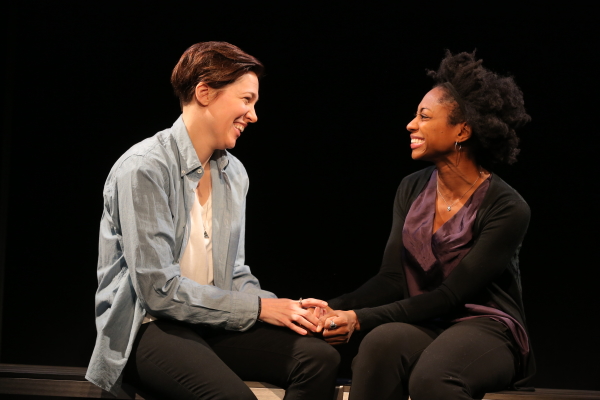Bright Half Life

(© Joan Marcus)
It may sound fatalistic to accept that every relationship has a half life — that true love is not an infinite resource destined to endure for eternity. It certainly defies the institution of marriage, whose romantic reputation hinges on this concept of "forever-ness." True, it's no fairy tale story, but Tanya Barfield's new two-hander Bright Half Life sacrifices none of its head-over-heels romance, even as its central couple spirals towards extinction.
Erica and Vicky, played by well-matched actresses Rebecca Henderson and Rachael Holmes, are at a turning point in their relationship. They have already parted ways but Erica is ready to revitalize the relationship with a full-fledged commitment. She sees children and weddings and years of marital bliss in their future and has a burning desire to make these shadows a reality. This is just the first of the play's nonlinear vignettes, which write the book of Erica and Vicky piece by piece — though there is plenty that unfolds both before and after this profession of undying love. The red-hot moments that shape the decades of their relationship burst like solar flares throughout the play, erratically filling in the unexplained holes and giving shape to the story before us. Still, an intelligent order can be found in this unpredictable sequencing, suggesting a far more intricate network of cause-and-effect than one that abides by the strict rules of chronology.
Lighting designer Jennifer Schriever and sound designer Bart Fasbender aid this storytelling structure with sharp cues, but Henderson and Holmes, in many ways, are left to their own devices to guide us through the disorienting narrative. One moment the women are enjoying an afternoon of mattress shopping, and the next they are long estranged with only their grown children linking them — all set within designer Rachel Hauck's bare metallic stage (smacking of Broadway's similarly abstract two-hander Constellations). Even with few safety nets, both actresses effortlessly maneuver through these instantaneous transitions, with detailed direction by Leigh Silverman, who builds their playful bond while successfully clarifying the piece as a whole.
Holmes is warm, yet single-mindedly driven as Vicky, offering a perfect foil for the directionless (and adorably acrophobic) Erica, who Henderson paints with humor, and at times, unchecked passion. A loving future seems destined as we watch their third-date rapport atop a ferris wheel. Sadly, a little perspective proves this to be just another solar flare of passion on the path to dormancy. As scenes like this ferris-wheel date are revisited, the women switch physical positions, as if, even in this perfect moment, the mechanisms that will ultimately force them to bypass one another have already been set in motion.
The process is slow but visible. Vicky's Type A personality — in one scene a harmless yen for cleanliness — becomes a substantial source of resentment toward an unmotivated Erica. Small tiffs about their racial differences and Vicky's fear of coming out to her parents (though Barfield graciously de-politicizes both of these hot-button topics) add to the list of hurdles that their relationship must overcome. Whether these moments are part of the burn or part of the fizzle is anyone's guess, but we can be sure that each one is an unavoidable part of the fiery life cycle of love.










